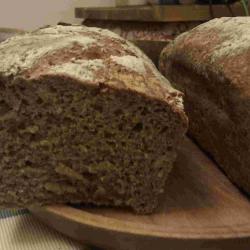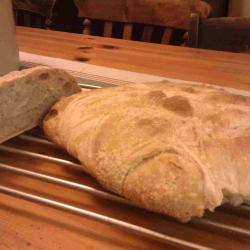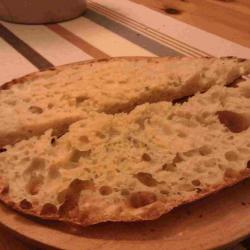
Many years ago, I used to make a fairly successful 100% wholegrain rye. The recipe called it a 'russian sourdough', and it was a very sticky, runny dough, but as it was baked in a tin it would usually work out fine. The loaves were a bit brick-like, but the sour flavour was so good, I virtually lived on the stuff.


Anyway, I lost my starter when I moved house; I took it for granted that I could start another culture as the first one had been easy. But every batch of starter developed a strong acrid 'bacon' smell. Not good! On the off-chance, I tried again last week and succeeded in getting a healthy starter going, so I've begun baking again with a vengeance!
I made a quick batch of russian wholegrain rye (above) just to test the flavour from the starter — it seemed as good as my old batch. And the loaves were as brick-like as ever, haha.
Wanting to be a bit more adventurous, I then made a white sourdough using the recipe here http://is.gd/GWkIzc It seemed a bit soft when I tipped it onto the pizza stone in the oven. Half of it oozed off the stone and started sliding down the oven door. Somehow, I managed to grab it and slap it back on the stone, and it seemed to behave from there on. That turned out quite well for a first attempt. Pleasantly chewy with a mild sourness. Most of it got eaten before I took a picture, it's on the left in this shot:

I wondered whether the dough was too soft because my starter was over-hydrated (for making rye bread, I always made a runny batter to encourage the sourness to develop). I'm used to making bread by guesswork and luck rather than measuring anything, but with all the talk of hydration percentages, I felt I should take weighing more seriously. Looking around for ideas, I came across the 1-2-3 method, which I used to make the loaf on the right. This time, the starter was 50/50 by weight (much more 'doughy' than anything I've used before). I used 200g starter, 400g water, and 600g flour (Dove's Farm organic strong white).
As before, I gave the mixture a quick stretch & fold every hour or so for three hours, then left it to prove for three hours in a colander lined with a cloth. I liberally coated the cloth with semolina. The dough seemed, if anything, even stickier than the previous batch. When I attempted to put it in the oven, it stuck to the cloth, then rapidly spread over the stone and started going over the edge and southwards. The children really seemed to enjoy the spectacle of me grabbing madly at the glutenous strands, burning myself, cursing and then slamming the oven door shut.
In consolation, it tasted pretty good (see crumb pic below), but I am pretty impatient so ate it warm and suffered terribly with indigestion. I know about indigestion, but what about the soft dough? Where am I going wrong?




Replies
Foss, after your 3 hour bulk proof, I assume you pre-shaped then shaped the dough before you left it in the cloth-lined colander for another 3 hours? That is, your BP was 3 hrs followed by a final proof of 3 hrs - correct?
What was your ambient temperature? I'm wondering whether you might have over-proofed the dough, which could have resulted in it going slack and sloppy.
Did you do a poke test?
Nice open crumb in that bottom pic, by the way!
Cheers
Ross
That's right, 3 hours for the BP, then attempted to shape the dough by stretching and folding at four sides and tucking underneath — it was quite difficult owing to the dough being so slack. There hadn't been much activity in the first three hours, just some smallish bubbles appearing towards the end. Then I proved the dough for about 3 hours, but checked it often to see if anything was happening. It didn't appear to be doing much at first, but had nearly doubled in size when I decided to bake. I did poke it right at the end, if anything it was still on the springy side.
Ambient temperature was between 19-20 C throughout the process .
I was careful weighing everything. Everything was weighed on the same scales, so any instrument error should have been consistent for all ingredients (they are very cheap scales). Even so, I keep thinking it was overhydrated; just can't understand how!
Would a lot more stretching and folding help?
The starter began life on rye, where it's thriving, but it doesn't seem as lively on white flour; I think it's still adapting, but seems to get the job done!
Cheers for the reply!
Sounds like you haven't tensioned the skin properly before you put it in the banneton (even though your crumb looks fabulous) - have a search on YouTube for shaping sourdough; there are some good videos there.
[quote=Merrid]
Sounds like you haven't tensioned the skin properly before you put it in the banneton (even though your crumb looks fabulous) - have a search on YouTube for shaping sourdough; there are some good videos there.
[/quote]
Thank you, I didn't realise how important 'shaping' was in forming the final loaf. Have just read the tutorial (by SourDom) and will post back when I've had another attempt.
Wonderful forum, I have learned so much here in the last few days!
Sorry, duplicate!
Had some better success with the same 1-2-3 recipe as above; this time I made an effort to 'pre-shape & shape' as mentioned by Ross and Merrid. SourDom's tutorial was a revelation — prior to reading that, I thought shaping consisted of a few pats and a squeeze.
I used a lot of rye flour and semolina on the cloth to stop it sticking while proving. When I tipped it onto the pizza stone, it more or less kept it's shape, though it began to spread under its own weight. When making a couple of panicked slashes on top, it cut rather than tearing, which must be due to tensioning the surface. I'm pleased with the result, I know it's not perfect, but there's been progress.
[URL=http://img43.imageshack.us/i/c36020110408105719s.jpg/][IMG]http://img43....
[URL=http://img191.imageshack.us/i/c36020110408103800s.jpg/][IMG]http://img19...
[URL=http://img825.imageshack.us/i/c36020110408110116s.jpg/][IMG]http://img82...
[URL=http://img263.imageshack.us/i/c36020110408110157s.jpg/][IMG]http://img26...
This morning while the children filed past to breakfast, I held the vast loaf-obelisk aloft, humming the tune from '2001, A Space Odyssey'.
'Looks a bit flat' said my daughter.
Kids; what do they know, they haven't even seen the film.
My recent efforts have all been somewhat "flat".
I suspect my hydration levels aren't right, because the dough is super sticky - I literally can't touch it without picking some of it up. After attempting to knead & fold for 30 seconds, I end up with a layer of dough about an inch thick stuck to my hands, some stuck to the board, and the 'dough' looking like a cat that fell into a vat of hair gel. If I press my palm onto it, about half the loaf would come up when I raised my hand. I ended up kneading in about another cup and a half of flour, and ended up with something much more resembling bread dough, though still very soft & sticky. Shaping the loaf is very difficult, to say the least!
After proving in a banneton, I invert the loaf onto a sheet of baking paper, and slide it onto the pizza stone in the oven, at which point it spreads out to about twice the width it started at, and about an inch and a half thick.
Tasty, but not exactly visually appealing.
My starter is 100g water, 100g flour (I have digital scales, and always go by weight).
Does that sound like the dough is too wet?
Could you let us know your dough composition by weight of ingredients? And the process you're using would be helpful, also (kneading, proof times).
Cheers
Ross
Hi Ross,
I used 1:2:3 starter:water:flour.
Although the flour I used was a rye mix, so that has probably complicated things. It may have a much higher moisture content than the white flour I normally use.
Kneading took a long time, somewhere upwards of an hour to mix & knead, although I didn't do much actually kneading, really only a few folds, then some more to knead in the extra flour - as I said, it was extremely difficult to do *anything* with the dough.
The bulk ferment time may have been a little too long - we went out to visit some friends, and ended up getting home about three hours later than I thought we would. I divided the dough into my two bannetons, and proved half on the bench overnight (cool conditions for Brisbane, about 15ºC), and the other half in the fridge (so at about 3-4ºC).
I baked the first loaf for 30m at 200ºC (non-fan-forced electric oven, on a pizza stone), then 40m at 180ºC. After slicing, it has a nice thick, chewy crust, and has a deliciously strong sour taste, but the crumb is, if anything, still a bit damp. That suggests to me that the dough was far too wet.
Having now also baked the loaf that was in the fridge, it didn't spread as badly as the one on the bench (which I'm pretty sure was over-proved), but still slumped a fair bit - even cold. Got a much better oven spring out of it, though it also cracked in a few places. I haven't sliced that one yet.
I'll see if I can upload a couple of photos - not sure how to get the img tag to play nice with Picasa weblinks, but these links should get you to the photos. The first one was proved in a long banneton on the bench, the second in a round one in the fridge.
https://picasaweb.google.com/lh/photo/OYYBPMjGwjwH9s5ohGpd8ncRsbNeI02uHU...
https://picasaweb.google.com/lh/photo/q8D8GrRcKZw1zXjFp9a_LncRsbNeI02uHU...
Bern, what was the proportion by weight of the flour in your 'rye mix'? (Looks like a high proportion of rye, going by your pic).
And how long in total would you say your BP was, approximately?
Assume you pre-heat your pizza stone?
A couple of observations:
1. If I understand you correctly, your FP for one of your loaves was overnight on the counter @ approx 15C. Combined with what sounds like a long BP, it sounds as though you may have overproofed this one. That may at least partly account for the flatness of the finished loaf (assume you've read the posts above re the importance of proper shaping).
2. My money would be on the over-moist crumb being a result of your relatively low baking temperatures. I find I get the sorts of results I'm after as follows (NB: this is just a guide...I keep notes of each bake so I can keep tweaking to attain the finish I want, and have found the following works for me...but most recipes I've come across either in the bread gurus' books or from home bakers on this and other forums only use one temp change per bake - or none. Bear in mind, then, that my method is somewhat idiosyncratic, and tweaked to factor in the vagaries of my oven and the sorts of SD formluae I like):
Heat the oven to max with the pizza stone and steaming tray if using (for my preferred steaming method see here). Load the bread, then drop to 235C or so, and maintain that for the first 15 mins (with steam), then take out steaming apparatus and drop to 215C and bake until the crust starts to take on the shade of brown you like or a bit lighter - this is around 15 mins for most of my breads. Drop to 200C for the rest of the bake (around 12 mins - but for a rye bread such as you're making, longer...consult your recipe and make an educated guess on the duration of this last period the first time you try these baking temps).
Cheers
Ross
Ross,
Not sure of the rye content - it's a flour mix my parents bought for me. Possibly a high rye content - which could account for the stickiness, I guess?
Answering your questions:
1) Yeah, I think you're right. Too long between mixing and baking - should have done that one in a tin!
2) Hmm, I thought I had the right temps, but now that you mention it, I was working from memory, so it's entirely possible I was trying to bake 30º cooler than I should have! I have to say, also, I don't have an oven thermometer, so I'm just going by the dial control on the (cheap'n'nasty) oven.
I'll try something different next weekend - have bought a new bag of white flour - I was out, which was the main reason I was using the rye mix for my first loaf of sourdough I've baked since my daughter was born six months ago! Still, I'm just happy the starter that had been sitting in a sealed jar in the fridge came good in only a couple of days. It was doubling in volume overnight after only a few feeds. :-)
Thanks again for the help. I'll get a notebook and keep track of what I do each time, so I can tweak things to suit my oven.
BTW, I don't have an oven thermometer either. My oven's not really cheap'n'nasty, but I wouldn't have a clue how accurate the temperature dial is. That's another reason to use my baking temps and times as a basic guide only. They work fine for me and my oven, but keeping notes and making tweaks for your breads and baking conditions is a good move.
I resisted being that organised for quite a while, but my bread baking stepped up another level from the point at which I started my first notebook - now I've filled a few of them! Indispensible, especially if you're baking a lot of different types of SD bread and other things like bagels, stollen, panettone, etc. Dunno about you, but I can't trust my memory on the finer details if there's a bit of time between bakes of something that's not one of my regulars. Add seasonal variations in temperature and humidity to the mix and ongoing tweaking and yer notebook's yer best friend!
Anyway, best of baking to you!
Ross